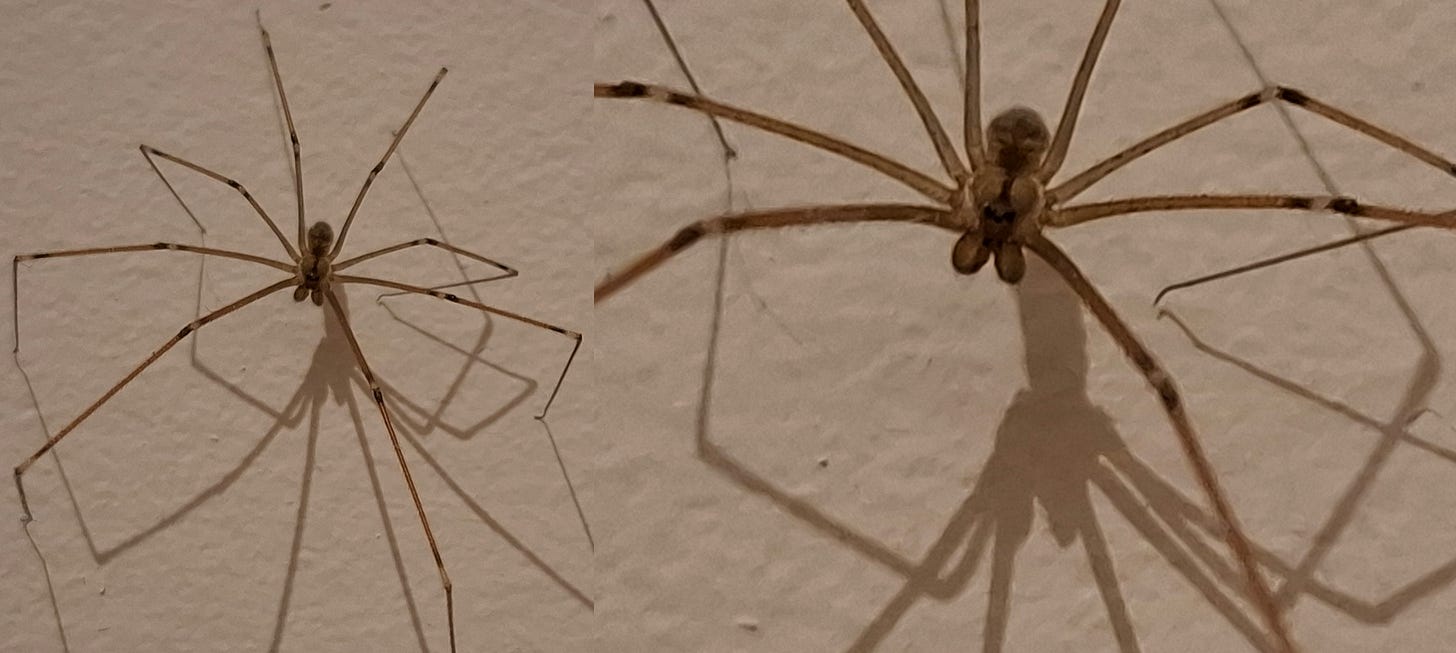Introduction - what makes a house, a house?
The construction of buildings is one of the most obvious ways in which humanity marked much of the landscapes we live in. Whether large or small, ephemeral or century-spanning, putting these structures together requires a mix of many of our most prized attributes, combining ingenuity, planning, tool use, and cooperative behaviour (highlighting the massive exertion of time and energy required to make a safe, cozy spot for oneself in this cruel world). Of course, we’re far from the only ones, and the list of other home-making species could go on for quite a while (although I think we have the nicest houses of the animal kingdom right now!).
As a result of our biological but also social preferences, the insides of current houses (in temperate climates at least) share a series of traits that put them seriously apart from their surrounding environments. The most significant is lack of moisture, since the elementary function of a house is protection from inclement weather, especially rain. As a reference point, the average desert receives fewer than 10 inches of rainfall per year, and only the Atacama desert can boast of enduring several years of total drought at a time1. Now think back to your living room: what has its annual rainfall been over the past few years? Probably not much better than the Atacama! The main exception is the bathroom, with toilets and kitchens also providing access to water. In some (unlucky) cases, basements can also exhibit significant dampness.
Next, and just as significant, is temperature control. The cold can kill in temperate climes, but so can sleeping in a greenhouse in a heatwave, so a house must stay within quite a narrow range of comfortable temperatures throughout the year. While it wouldn’t be unusual to see variations in temperatures in the order of 30°C between the coldest and warmest months in temperate regions, it’s unlikely the seasonal variation in a house is much larger than 5 or 10°C throughout the year, generally staying closer to the outside spring and summer temperatures observed in the area. This can also be affected by the quality of one’s insulation, the age of the house, and the efficiency of the central heating and air-conditioning. Here as well, there are some exceptions, such as attics which tend to be warmer than the rest of the house in the summer, and basements which tend to be cooler thanks to the surrounding soil acting as a buffer.
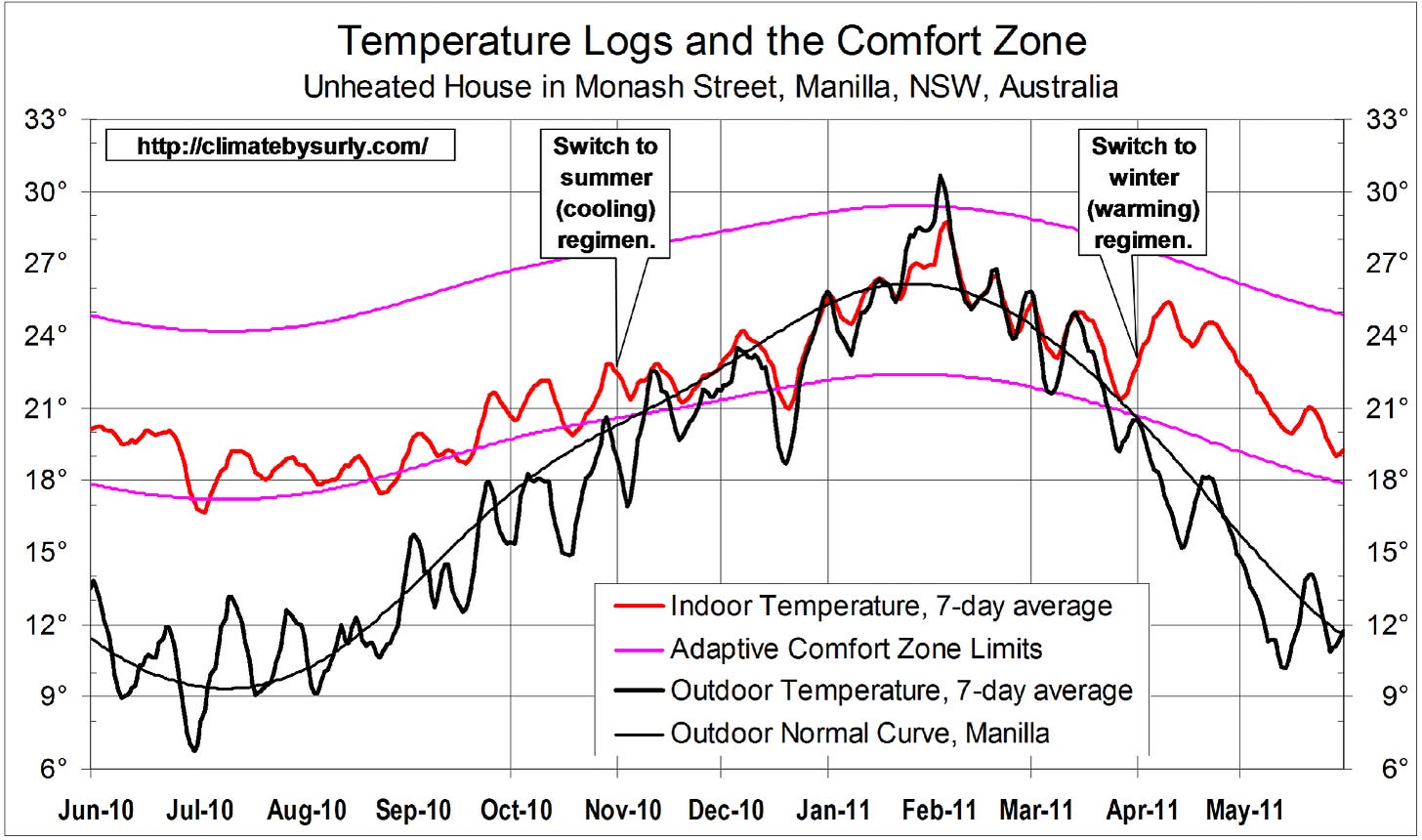
To achieve these two feats, namely, staying bone-dry year-round, and keeping a fairly constant temperature, a house must necessarily be, to a degree, cut off from the surrounding environment. This leads to a third characteristic of houses, which is that they are to a large degree isolated from the outside world and especially its ongoing ecological processes. Because of this, relatively limited amounts of organic matter penetrate on their own, whether living or inert. Once again, the major exception is what’s brought in by the occupants of the house, be it food (on average 2.9 kg of food and beverages combined are consumed per adult per day in France2) or lost biomass (between 0.72 and 2.16 grams of dead skin shed every day, one of the major components of house dust3, to say nothing of shed hair, sweat or oily skin secretions).
To summarize the above, houses can be described as a man-made environment defined by high thermal inertia (temperatures are relatively constant throughout the year except in very specific rooms), low water availability (once again excepting a handful of very specific, and often hard-to-reach, locations) and low available biomass (grams of dead skin and crumbs of food, vs the tens of tons of biomass per hectare in Mediterranean forests4, which would still represent tens of kilograms of biomass if scaled down to the surface of the average western house).
This would seem, at face value, to make houses a poor habitat for organisms unable to make full use of their amenities, and yet this is not the case. A few hardy species of animals are able to survive and even thrive within the “house ecology”, some having done so for so long, that it’s hard to imagine they ever managed to do without it. The goal of this post is to shine a spotlight on these discreet creatures and explain what adaptations made them uniquely suited to colonize this unlikely habitat. The word of the day is thus “synanthropic”, organisms which must live in close proximity to humans and their dwellings while deriving a benefit from them. This doesn’t imply any conscious domestication took place, although human activities may heavily influence their reproductive success and this act as a selection pressure.
Spiders
I am now front-loading the post with the really creepy crawlies and keeping the cute ones for the end. Spiders aka arachnids are 8-legged arthropods possessing spinnerets, glands located on the 4th and 5th abdominal segments which produce silk (the most significant synapomorphy, or shared ancestral trait, of all arachnids5) as well as mouth-pieces called chelicerae (hook-shaped mouth-pieces combined with venom sacks, or else tiny pincers, depending on the group of spiders). This obligate predatory clade developed a wide variety of feeding strategies throughout its approximately 380 million year long history6. Some are ambush predators, others actively pursue their prey and finally others lay cunning traps of silk for their prey to fall or entangle themselves into. It’s this last group that found a safe haven within human habitations.
The most ubiquitous house-spider in Europe is Pholcus phalangioides, the cellar spider or daddy-long-legs spider. It’s only one of the 1900 recorded species of pholcid spiders worldwide7. With its extra creepy stick-thin legs and respectable size for an arthropod (up to a couple of inches across, legs included), it’s not a welcome guest in most households. It typically spins a relatively small, unstructured web in a quiet corner. Surprisingly, it’s a household superpredator, as much able to capture insects that wander into its web as it is capable of invading the webs of other spiders or raiding their egg pouches. It’s been observed to carry out “aggressive mimicry”, vibrating like a prey insect trapped in another’s web to lure its occupant in and ambush it, with a high success rate. It’s even able to subdue other species of spider as large or larger than it is8. It’s also known to subdue venomous spiders that are dangerous to humans, especially in Australia, and as such is seen as a useful pest control auxiliary.
Now, for someone observant of natural patterns and curious enough, a question may have emerged at one point in your life: “How come I’ve never seen one of these things outdoors?” (this assumes you live in a temperate or Mediterranean climate). And the answer, surprisingly, is that this ubiquitous spider is simply not build for our weather. The species is originally from Asia, having established itself in Europe within the last 200 years, among other arthropod species. It’s estimated that it stood to gain from improvements in central heating, and will only keep doing so as insulation and energy efficiency improve9. This family originally being from tropical and subtropical locales, it’s unable to survive in temperate winters, to the point that there is a noticeable genetic drift in cellar spider populations within a single building, which is equivalent to that between populations of free-roaming European spider species separated by a distance of tens of kilometres10.
Another extremely common group of spiders found in homes, the bane of arachnophobics everywhere, are the genuses Eratigena and Tegenaria, which contain species such as the giant house spider (Eratigena atrica), the common house spider (Tegenaria domestica) and the hobo spider (Eratigena agrestis). The two groups used to form the single genus Tegenaria until a 2013 paper11 modified their taxonomy based on genetic data. These large, brown, physically similar spiders are funnel web weavers that often occupy corners or dark sheltered areas in houses, especially E. atrica. Both Eratigena species originate from Europe and were introduced accidentally to North America approximately 100 years ago12. With a leg-span reaching over 3 inches, E. atrica is one of the largest European spiders and also has the distinction of being one of the fastest land spiders, with a top speed of 50cm per second13 (which translates to a leisurely 1.8 kph but that’s a lot when you’re 3 inches long). These species occur in the wild outside of houses but always in sheltered spaces such as tree crevices or rocks, thus they naturally have a predilection for dark sheltered corners, making houses attractive for them. They’re most visible in the Autumn when males wander out in the open in search of a female to mate with before the winter.14
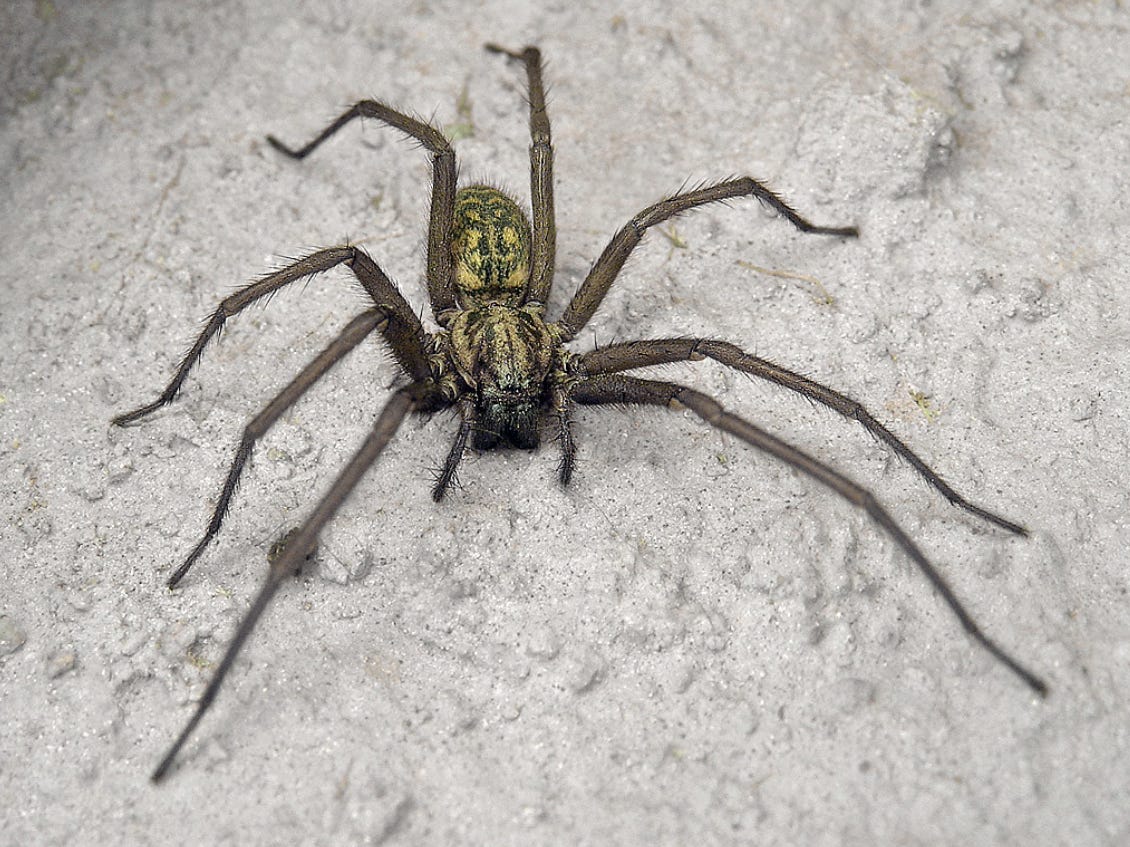
Now that we know what drew them to this habitat and keeps them there, how do they cope with the two biggest downsides of the house ecosystem, namely, scarcity of biomass and water? This is due to spiders having a naturally low metabolic rate for their size, believed to be an adaptation to their predatory lifestyle marked by the risk of food scarcity. While web-weaving spiders such as P. phalangioides have a higher metabolism than non-web spinning spiders, it’s still lower than that of other similarly sized arthropods15. While I can’t find an acceptable source on this, common wisdom seems to be that they get what few fluids they need to stay hydrated through their prey, or occasional small pockets of condensation near windows.
Centipedes
These creepiest of crawlies hail from the subphylum Myriapoda, a strictly terrestrial group of many-legged arthropods. Few of them are present in temperate areas, although one Mediterranean species has adapted very well to houses. Scutigera coleoptrata, known as the house centipede, possesses 15 pairs of legs in the adult stage, and is capable of regenerating any losses within a single molt cycle, provided the detaching of the limb occurred at least 7 days before molting. This is known as “explosive regeneration”. Being prolific predators of most arthropods smaller than themselves, and using their long legs to scuttle at high velocity, such an ability is highly advantageous to them.16
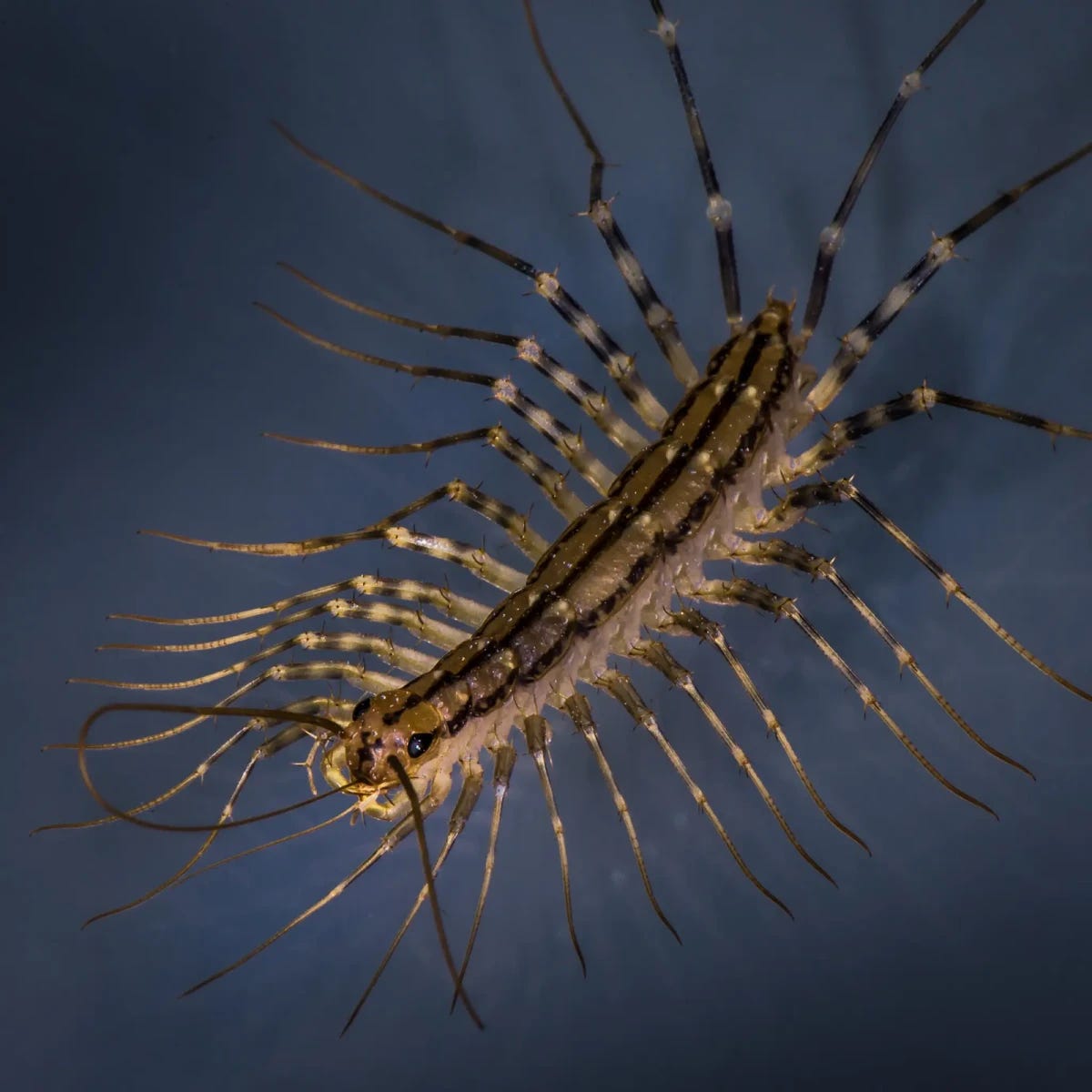
This voracious predator, with a body length around 3.5cm which can be doubled by its long legs and antennae, eats numerous prey items found in houses including cockroaches, carpet beetles, and spiders, using its venomous bite. It originally hails from the Mediterranean (living in rocky areas where they shelter in cracks and beneath rocks before leaving to hunt at night), and, like the cellar spider, it adapted to houses, which allowed it to live outside of its mild climatic zone, leading it to eventually develop a cosmopolitan distribution17, including obviously in areas where it can’t survive outdoors in the winter. It should be noted that Australia has its own very similar species of house centipede (Allothereua maculata), although both can be found in Sydney18.
Overall, house centipedes manage to survive by hunting at night for whatever other arthropods they can find in their vicinity, and their presence in a household can be indicative of a deeper pest infestation problem, as they are unable to survive in any large numbers without a steady food source. For example, their presence in sufficient numbers may be an indication that you have an infestation of our next topic…
Cockroaches
While our previous entries may be fear-inspiring, these ones are a whole other level of bad news if they appear in your dwelling. In Europe, buildings may be colonised by the German cockroach Blattella germanica. This relatively small member of the order Blattodea feeds on scraps of food, or feces, hiding in areas such as corners, door and window frames, heat vents or openings for pipes19. They display a gregarious behaviour, nymphs coming together in tight groups in response to olfactive stimuli contained within cockroach feces20. They are considered pests on account of their affinity for decaying food, feces and organic matter, which can lead to them carrying pathogenic bacteria, tainting food preparations, and causing allergic reactions in humans they share buildings with21.
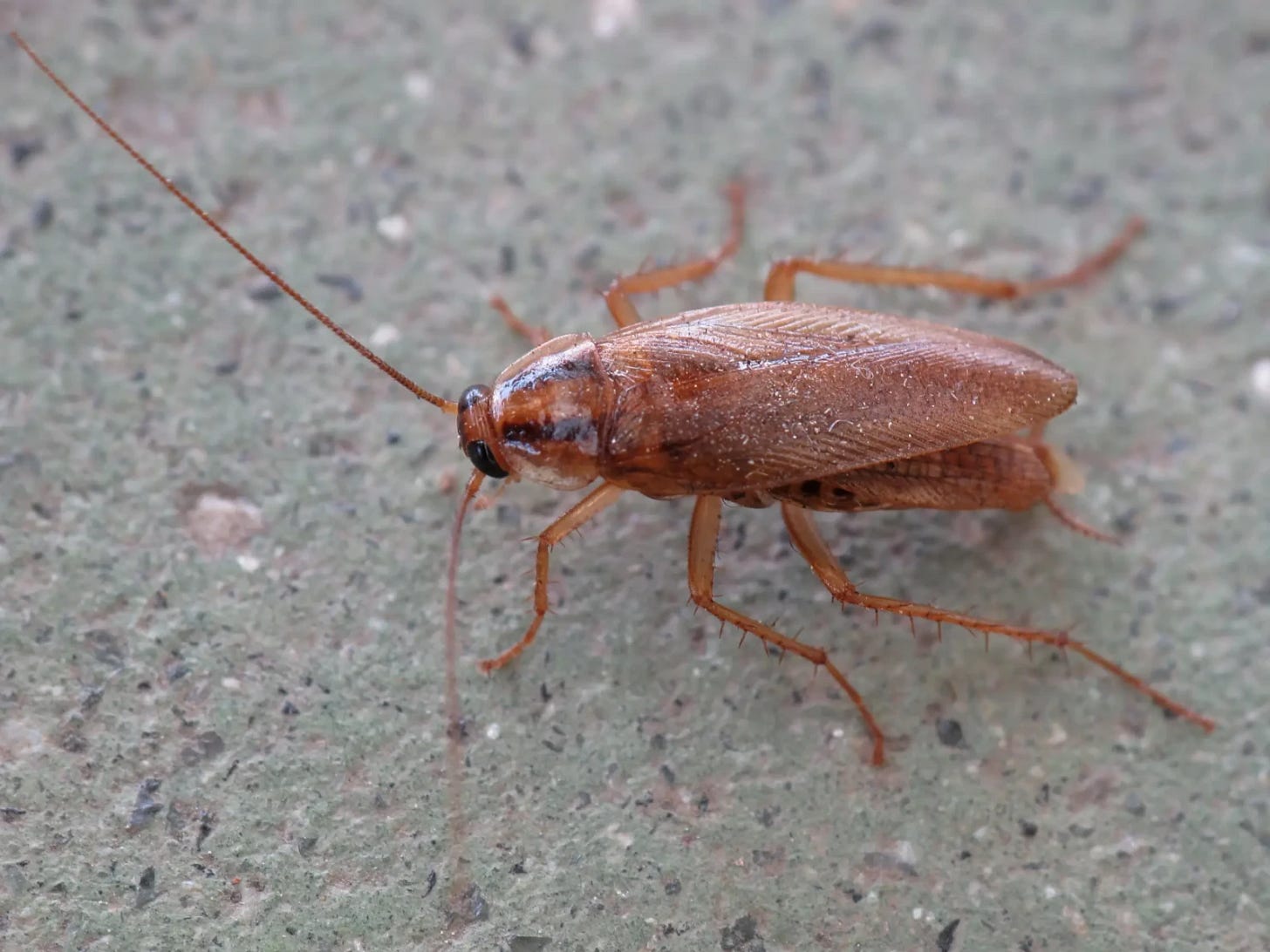
Much like the house centipede and the cellar spider, this species is not indigenous to temperate Europe (and the rest of the temperate world where it also occupies buildings and other human structures). This species, which isn’t found in the wild anywhere in the world, was first described in central Europe in the 18th century (hence its name), but recent genetic analyses showed that it is in fact a recently derived relative of the South and South-East Asian Blattella asahinai, which adapted to a synanthropic lifestyle around the 1st century BC. It was spread westwards in several pulses by the Islamic caliphates, as well as, later, by European trade and colonialism in and around India, possibly thanks to its affinity for stowing away in food supplies. It was able to displace other local cockroach species thanks to its smaller size (lower dietary needs, short generation time) as well as its high reproduction, which allowed it to easily develop a high insecticide resistance 2223.
Like the cellar spider it shares a broad biogeographical origin with, it depends on artificially heated structures for survival in climates colder than its native subtropical regions. To make matters even more confusing, the American cockroach (Periplaneta americana), the largest of the house cockroaches (whose lifestyle is nonetheless broadly analogous to that of the German cockroach except it’s less mobile between buildings) isn’t actually from America, but is believed to originate from Subsaharan Africa24.
Since these animals mainly feed on decaying organic matter, their presence indicates issues in this regard in the vicinity. This can include large amounts of leftovers left to rot too long in a corner or near the house (garbage bags and containers, or similar detritus), food left out in the open, human or animal feces in the premises, etc…
Earwigs
The European earwig (Forficula auricularia) actually is, for a change, from the place its name says it’s from. This small order of insects (Dermaptera) contains some 1900 species worldwide, only 9 of which live in Europe. Their most caracteristic trait is the large forceps-like pincers at the end of their abdomen, which have been recorded being used in such various contexts as reproduction, territorial displays, subduing prey or on the contrary defending against predators. It currently has a cosmopolitan and is considered an invasive species in North America. The species thrives around human habitats, being especially prevalent in greenhouses and houses, and this allows it to live in colder climates than it could normally handle, such as Iceland. Being omnivorous, it can feed on insects as well as plant matter, especially, because of the relative weakness of its mandibles, the more delicate portions of plants such as inflorescences, or fruits that were damaged by other insects such as wasps. The species produces one or two clutches of up to 50 eggs per year, with significant parental investment by the mother, who feeds its young.25
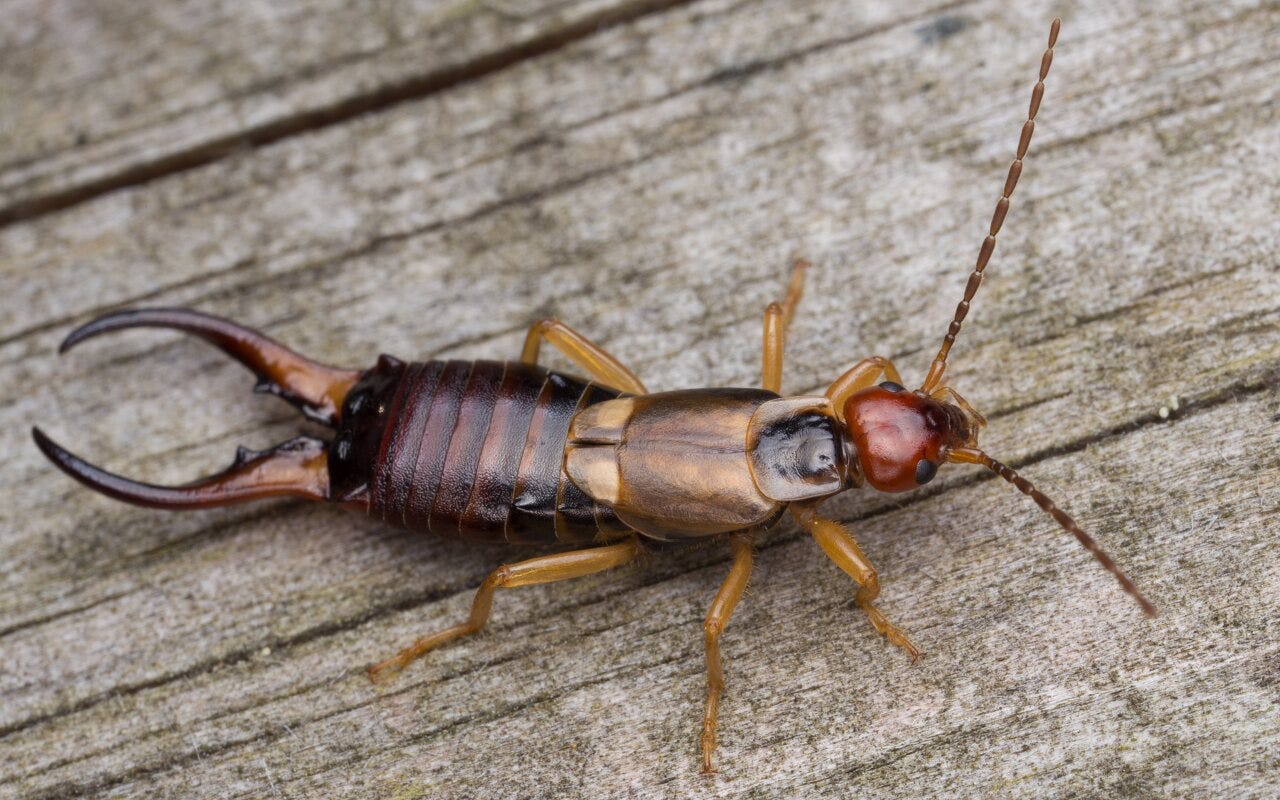
The species first appeared on the West coast of the USA in 1907 (Seattle) and on Rhode Island for the East coast, going through phases of explosive growth unknown in its native European environment. While it was feared it’d become a crop pest, it mostly didn’t live up to contemporary fears, rarellly causing major agricultural damage, instead becoming a reoccuring pest in urban areas 26. Meanwhile, in Australia, where it was introduced around 170 years ago, it’s considered a pest in certain types of soft-fruit orchards as well as a potential contaminant during harvest.27
Their original ecosystem being forested environments with dead wood and piles of dead leaves, they are adapted to crawling inside narrow, dark cracks and seek such environments inside houses as well. Their omnivorous diet allows them to make the most of their surroundings when in human habitations, feeding on insects as well as food items or plants.28
Silverfish
These insects (Lepisma saccharinea) have some of the most preserved primitive morphologies of their entire group, giving us a glimpse of this clade as they once were, at the dawn of time. Their name comes from the layer of tiny silver scales covering their cuticle, and the undulating motions they make when scuttling across a room. This cosmopolitan species of forest floors feeds on all sorts of carbohydrates and starches, and in houses is able to eat textiles, dead skin, paper, some types of pastes, glues and bindings, or even food such as flour or breakfast cereals. Preferring a temperature in the mid twenty degrees Celsius, and a humidity level above 75%, they’re most frequently found in bathrooms, toilets, cellars, and the cabinets below kitchen sinks. They’re common prey items of spiders and house centipedes. Their bodies are so flat that they’re said to be able to squeeze between the pages of a closed book (to eat them, unfortunately). They’re relatives of other synanthropic insects called firebrats (Thermobia domestica), so-called because they appreciate temperatures in excess of 30°C, near fireplaces, hot water pipes and radiators.293031
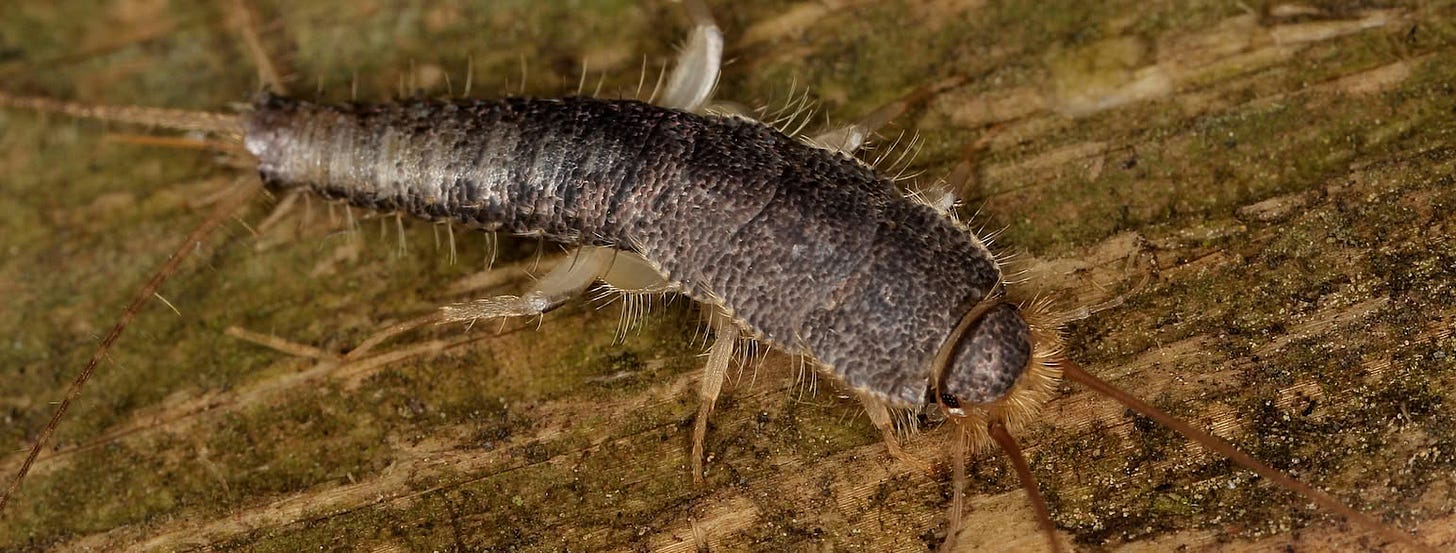
In nature you’d find the silverfish under piles of rotting leaves and wood, munching on decaying organic matter. Its presence in houses beyond a certain number may be due to a surplus of food residue or leftovers out in the open.
Carpet beetles
This charming group of small insects in the genus Anthrenus (the most common being the variegated carpet beetle A. verbasci) is very common in households, where they feed on all types of dry organic matter including but not limited to organic textiles, hairs, dead insects, dead skin and fur. In the spring, the hairy larvae (about 5mm in length) emerge and start gorging on all susceptible food sources, often solitary but sometimes in clusters, where they can cause significant damage to textiles that have been in long storage or always stay in the same place, including carpets, sheets and old clothes. They eventually pupate into their cute (similarly-sized) adult form, which accumulates around windowsills, trying to escape to the outside, as the adult strictly feeds on pollen and flowers (but comes back inside to lay its eggs). The natural habitat of the larvae is animal nests and burrows as well as decomposing bodies.32
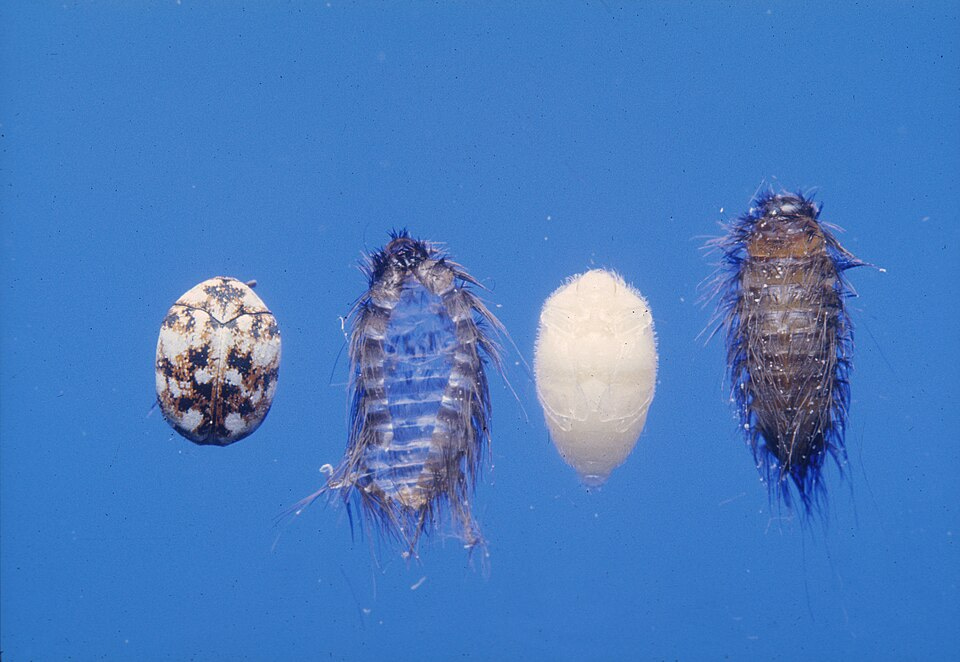
Since their diet is quite varied and includes many things that it’s impossible to do without in a household, their presence is always at somewhat of a constant indetectable low level at best. They’re considered particularly destructive in museums where their larvae may feed on pinned insect specimens, taxidermied animals, and old clothes and tapestries.
Moths
While butterflies are well known and liked by everyone thanks to their bright colours and delicate wingbeats, moths are a far more maligned group of insects. Many of their larvae (caterpillars) feed on important crop plants, and they often display a muted palette of colours, making it easier to mentally classify them as pests as they can be less visually attractive. The diversity of moths is however far greater than that of their cousins the butterflies, with almost 20x more species of the former than the latter in Western Europe. Since many of these species are very small (easily dwarfed by even the smallest butterflies) and/or nocturnal, it’s very easy for them to go unnoticed.
Among the myriad of strictly wild moths that only accidentally end up in houses due to their fabled attraction to artificial light, there are a few notable species who’ve adapted to the environment, as they find the food sources they need within. One of the most common house pest moths is Tineola bisselliella, the common clothes moth. The tiny yellow caterpillar eats all types of textiles, and is also among the relatively few arthropods with the ability to digest chitin, thanks to a very powerful midgut (impressive considering the insect’s less than 1cm long). It spins a tunnel of silk around itself as it eats, possibly as a combination of camouflage, physical defense and protection against dessication.
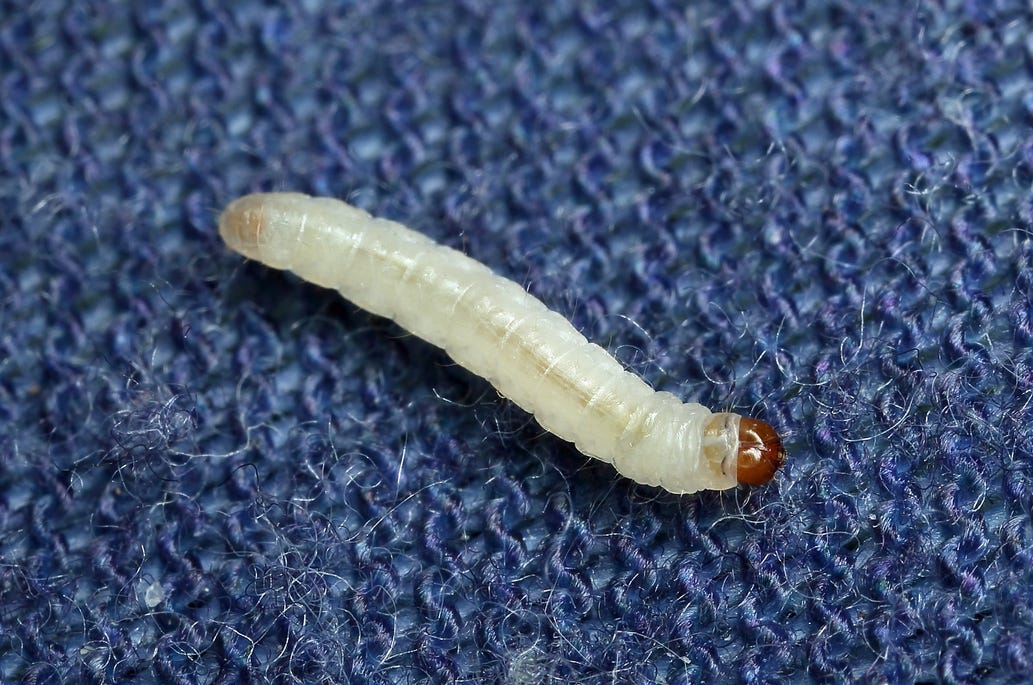
They’re also noted as being able to feed on meat (even whalemeat, mouse corpses and human bodies), bonemeal, blood powder, soybean meal and fishmeal. In the second half of the 20th century, surveys and studies estimated the damage caused by textile-eating moths in Great Britain, the common clothes moth chief among them, was of the order of millions or tens of millions of pounds per year. It’s believed the rise of synthetic fibers led to their decline since then, although they’re still able to feed on mixed organic and synthetic textiles by teasing out the edible fibers, or eating entirely synthetic fibers stained with sweat, oils from human skin, or food. It’s able to survive perfectly well in the dry habitat of human buildings, as it has the ability to derive metabolic water from the breakdown of keratin, with hatching and growth unaffected by humidity levels as low as 20% (half of the “ideal” humidity level for a room in a house).
Its origins are shrouded in mystery, but common belief states that it originates from South or Central Africa and was spread through human activities and trade (being a frequent pest aboard ships in the age of sail). The species was not describe by the great European taxonomists of the eighteenth century and the first reports only appear in the nineteenth, indicating a relatively recent introduction. Ancient and numerous descriptions of cloth-eating moths in the Bible and other ancient sources such as Plutarch are likely to describe other, nowadays less common species of keratin-digesting moths such as the genuses Hofmannophila, Tinea and Monopsis, whose larvae live in a mobile case of silk, as opposed to the immobile silk tube of the clothes moth. Otherwise, the adaptations, synanthropic qualities and life-history traits of all these moth species are remarkably similar to those of the common cloth moth, and can broadly be considered the same as far as these general explanations go.
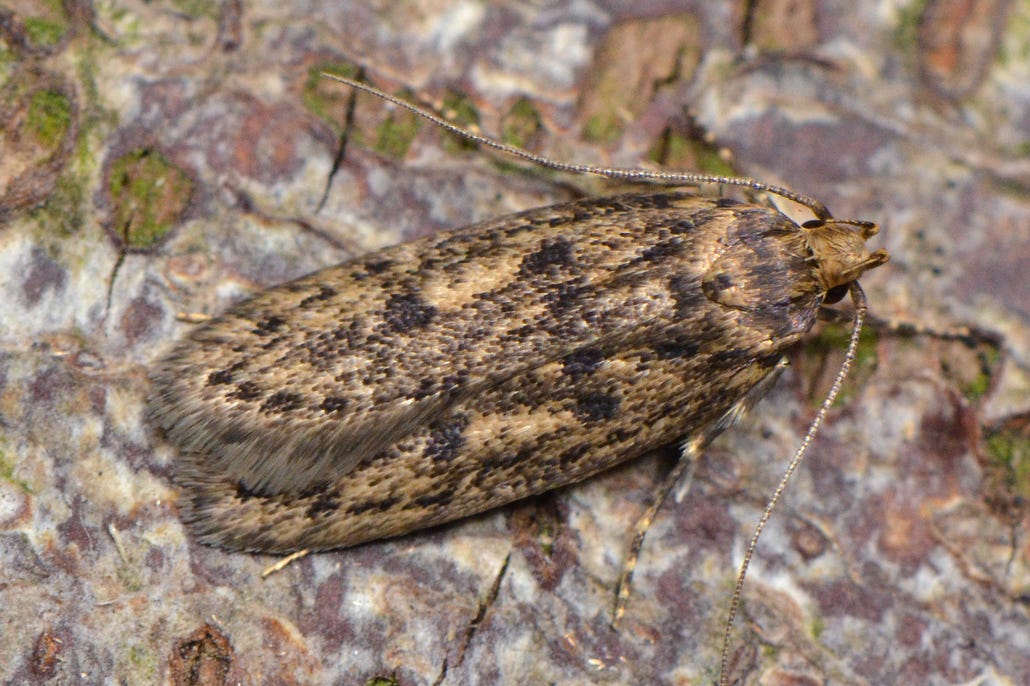
The natural habitat of all cloth-eating moths, like carpet beetles, may have been nests, burrows and animal corpses. Being small, highly light-averse, and relatively weak flyers (males are only known to fly up to 90 metres from their area of pupation, and females prefer scuttling on the floor instead) the light-brown imago (adults) of the common cloth moth are seldom seen unless specific traps are laid out for them. In the sheltered conditions of temperature inside a house, they can go through several generations per year uninterrupted3334.
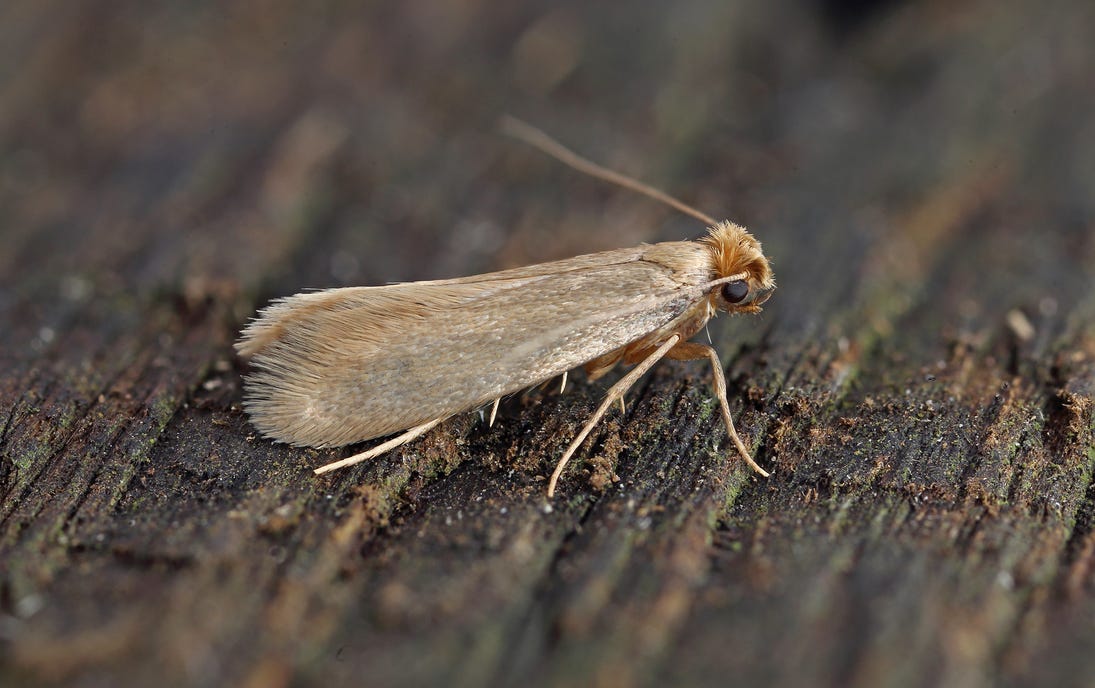
There are two final moths worth mentioning. First, the Indianmeal moth (Plodia interpunctella), which feeds on fruits and dry foods such as cereals, nuts and some types of candies. The larvae continually spin a silky coccoon (covered in the insect’s waste and discarded molts) over themselves and their food as they eat, leading to contamination and loss of food shipments. The caterpillars are able to chew through cardboard, and in the final larval instar before pupation can travel long distances relative to their size, meaning that contamination in warehouses and flour mills is very frequent35. Second, the Mediterranean flour moth (Ephestia kuehniella), which is better adapted to temperate climates, able to develop even at 12°C, although it grows best at temperatures around 25°C. The caterpillars of this species only eat grains, grain residues, and flour and is a pest in industrial scale food treatment plants dealing with flour.36
Anecdotally, for the past 3-4 years, there have been constant infestations of Indianmeal moths inside the bulk bags of birdseed my parents buy from the pet store, and they regularly spread throughout their house (although they don’t last long, and never seen to have time to lay eggs).
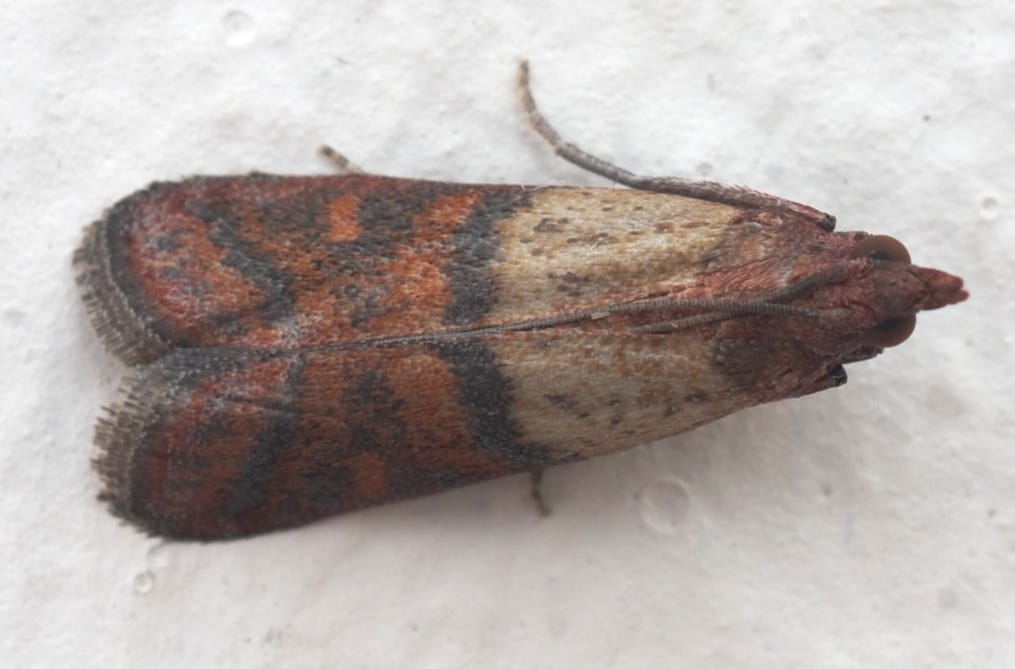
Conclusion
As (often unwitting) ecosystem engineers, human exert a gravitational pull on a wide array of animal and plant species, drawing them to our side by the ecological conditions we create for ourselves and our activities. While some of these happy accidents have brought us much joy and good fortune (dogs, cereals), they can’t all be winners. By creating artificial and mostly sealed off ecological islands, then travelling to the ends of the world and back, we’ve brought into being, piece by piece, whole new ecosystems where species from across the planet come together to exploit the resources left in the wake of our daily lives. Who can imagine what new organisms might slot into this paradigm within the next century, as international trade and travel continue apace?37
Tanase et al., 2024. https://doi.org/10.1016/j.envres.2024.119432
Mariano-Martins et al., 2020 https://doi.org/10.3389/fevo.2020.00109
Selden et al., 2013. https://doi.org/10.1007/s12542-013-0198-9
World Spider Catalog, 2025. https://wsc.nmbe.ch/family/76/Pholcidae
JACKSON, R. R., & BRASSINGTON, R. J. (1987). The biology of Pholcus phalangioides(Araneae, Pholcidae): predatory versatility, araneophagy and aggressive mimicry. Journal of Zoology, 211(2), 227–238. http://dx.doi.org/10.1111/j.1469-7998.1987.tb01531.x
Szinetár et al, 2020. https://doi.org/10.1007/s42977-020-00009-5
Schäfer et al, 2001. https://doi.org/10.1046/j.1365-2540.2001.00815.x
Bolzern et al, 2013. https://doi.org/10.1111/zoj.12040
Vibert et al, 2017. https://doi.org/10.4039/tce.2016.73
Canals et al, 2015. https://doi.org/10.1111/phen.12108
Barutia et al, 2024. https://doi.org/10.1186/s12983-024-00544-0
Jacobs & Skvarla, 2023 https://extension.psu.edu/house-centipedes
Rivaut, 1990. https://doi.org/10.1111/j.1570-7458.1990.tb01418.x
Ishi et al, 1968 https://doi.org/10.1007/BF02136814
Menasria et al, 2014. https://doi.org/10.1179/2047773214Y.0000000136
Tang et al, 2024. https://doi.org/10.1073/pnas.2401185121
Tang et al, 2019. https://doi.org/10.1007/s10530-018-1865-2
Ma et al, 2019. https://doi.org/10.1002/ece3.5777
Foottit et al, 2018. https://doi.org/10.1002/9781118945582.ch12
Guillet et al, 2012. https://doi.org/10.4039/Ent13249-1
Hill et al, 2018. https://doi.org/10.1002/ps.5192
Plarre et al, 2011. https://doi.org/10.4081/jear.2011.83
Cox et al, 2007. https://doi.org/10.1016/j.jspr.2005.08.004
Mohandass et al, 2007. https://doi.org/10.1016/j.jspr.2006.08.002
Jacob et al, 1977. https://doi.org/10.1016/0022-474X(77)90009-1





